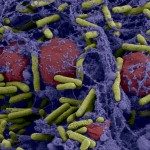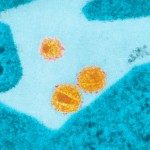Link to Pubmed [PMID] – 10926931
J. Biol. Chem. 2000 Nov;275(45):35137-45
The envelope glycoprotein of human immunodeficiency virus type 1 (HIV-1) is thought to exist on the virion surface as a trimer of non-covalently associated gp120/gp41 molecules. We expressed trimeric envelope glycoprotein from three primary, macrophage tropic HIV-1 isolates in baby hamster kidney cells and analyzed the furin-mediated cleavage, stability, and receptor binding properties of the oligomers. The envelope glycoprotein was secreted in a soluble form deleted of its transmembrane anchor and the intracytoplasmic domain (gp140). A mixture of trimers, dimers, and monomers of gp140 as well as monomeric gp120 was detected on polyacrylamide gels. Analysis by sucrose gradient centrifugation revealed that trimers and dimers were essentially composed of uncleaved gp140, whereas most of the gp120 was found in the monomeric fraction. To analyze the effect of the cleavage of gp140 to gp120/Delta41 on trimerization, we co-expressed the furin protease along with gp140. Surprisingly, furin expression changed the subcellular localization of the envelope glycoprotein, which became in majority sequestered in the major furin compartment, the trans-Golgi network, as judged by confocal laser microscopy. The envelope glycoprotein secreted from furin-co-expressing cells was almost completely cleaved to gp120 and Deltagp41, but gp120 was found exclusively in the monomeric fraction, with a few residual oligomers being composed of uncleaved gp140. Secreted uncleaved gp140 trimers were purified to homogeneity and analyzed for their capacity to interact with cellular receptors CD4 and CC chemokine receptor 5 (CCR5). Receptor binding was analyzed on CD4- and CCR5-expressing cells as well as on peripheral blood mononuclear cells. Trimers showed greatly reduced binding to CD4 as compared with monomers. Neither monomers nor trimers bound directly to CCR5. In conclusion, our results show that the cleaved form of the envelope glycoprotein does not form stable trimers, suggesting that gp120/gp41 oligomers on the virion surface might be stabilized by a yet to be identified mechanism and that the virion might attach to CD4 via a monomeric form of gp120. These results are relevant to the development of an envelope-based vaccine against AIDS.

